The Intel SSD 540s (480GB) Review
by Billy Tallis on June 23, 2016 9:00 AM ESTATTO
ATTO's Disk Benchmark is a quick and easy freeware tool to measure drive performance across various transfer sizes.
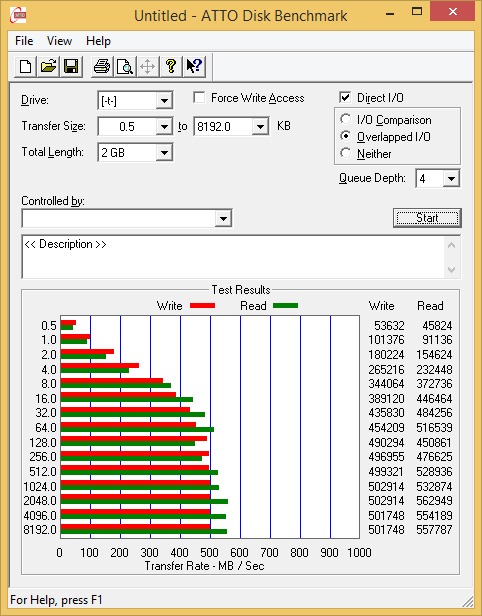 |
|||||||||
The Intel 540s's performance is a bit uneven during the ATTO benchmark, but its write speed advantage over the SP550 is still quite clear.
AS-SSD
AS-SSD is another quick and free benchmark tool. It uses incompressible data for all of its tests, making it an easy way to keep an eye on which drives are relying on transparent data compression. The short duration of the test makes it a decent indicator of peak drive performance.
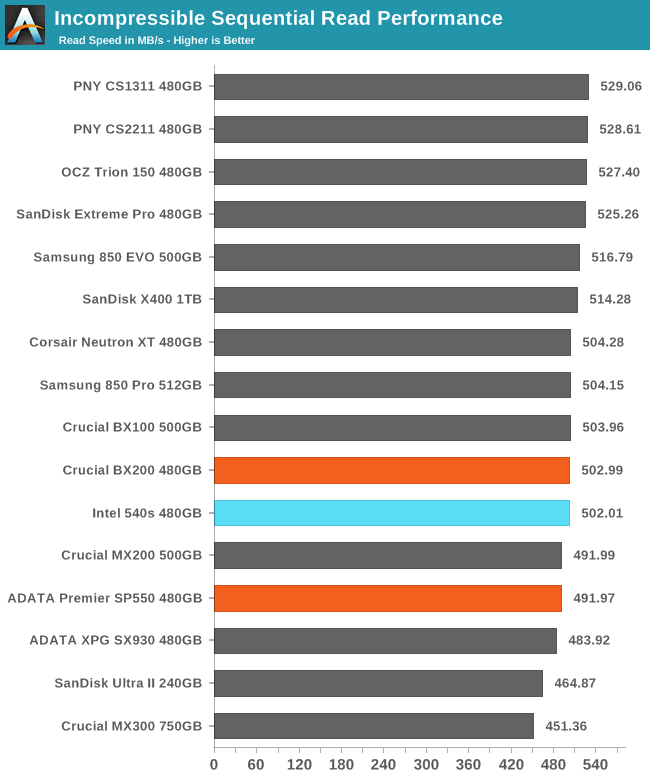
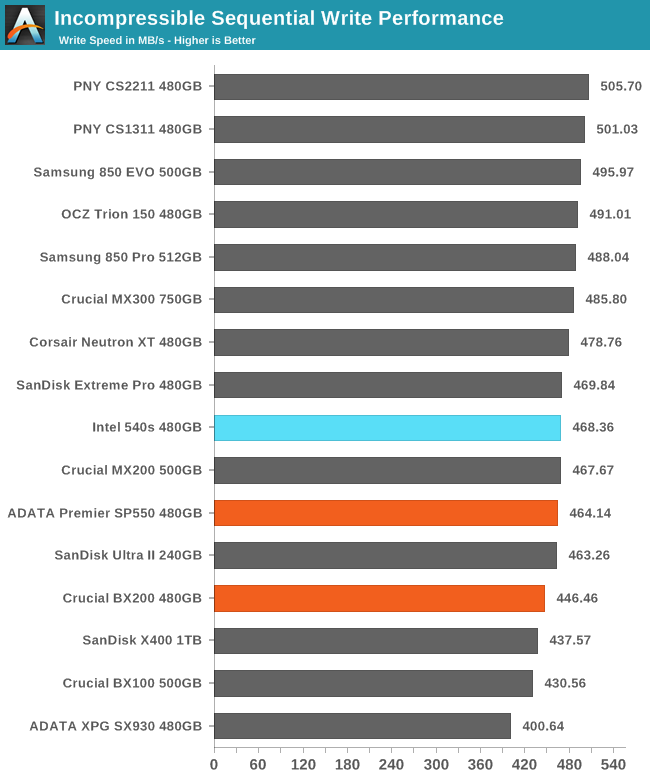
The AS-SSD test does very little to differentiate between drives, but it at least shows that the Intel 540s can reach similar peak speeds to its competition.
Idle Power Consumption
Since the ATSB tests based on real-world usage cut idle times short to 25ms, their power consumption scores paint an inaccurate picture of the relative suitability of drives for mobile use. During real-world client use, a solid state drive will spend far more time idle than actively processing commands. Our testbed doesn't support the deepest DevSlp power saving mode that SATA drives can implement, but we can measure the power usage in the intermediate slumber state where both the host and device ends of the SATA link enter a low-power state and the drive is free to engage its internal power savings measures.
We also report the drive's idle power consumption while the SATA link is active and not in any power saving state. Drives are required to be able to wake from the slumber state in under 10 milliseconds, but that still leaves plenty of room for them to add latency to a burst of I/O. Because of this, many desktops default to either not using SATA Aggressive Link Power Management (ALPM) at all or to only enable it partially without making use of the device-initiated power management (DIPM) capability. Additionally, SATA Hot-Swap is incompatible with the use of DIPM, so our SSD testbed usually has DIPM turned off during performance testing.
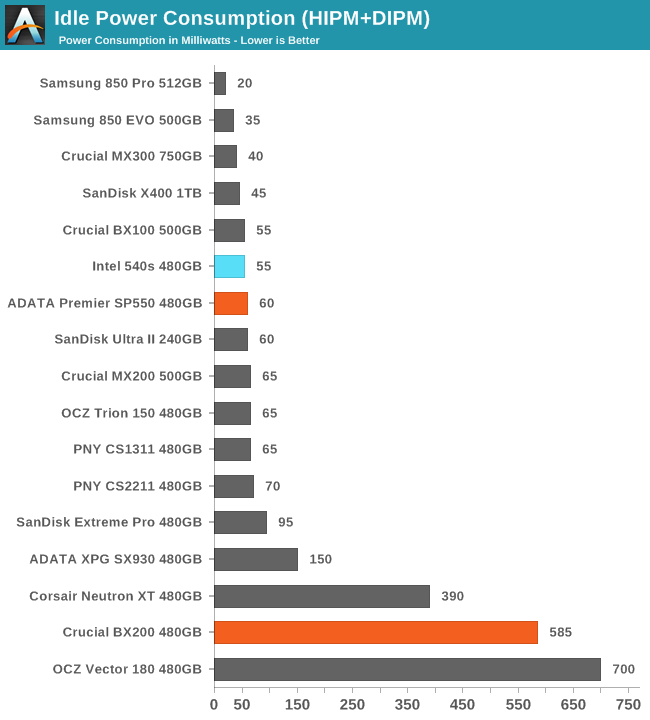
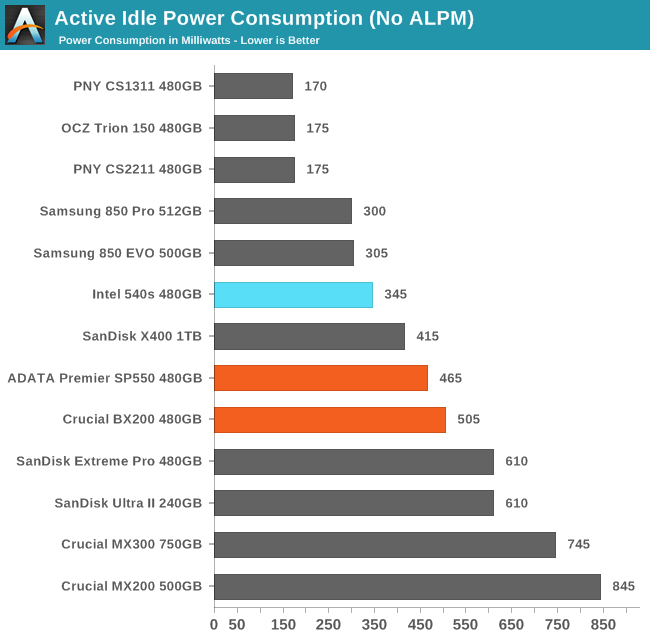
The slumber power state is working correctly on the Intel 540s and allows for very slightly lower idle power draw than the SP550. Active idle power is significantly improved over the SM2256 and is now behind only Samsung and Phison controllers. Silicon Motion's 40nm SM2258 clearly beats Marvell's 28nm 88SS1074 used in the SanDisk X400 and Crucial MX300.










77 Comments
View All Comments
Flunk - Thursday, June 23, 2016 - link
Looks like it's on Intel's low-end product map for well into 2017 (which is as far as that goes).BurntMyBacon - Friday, June 24, 2016 - link
I thought that Intel's low-end was the 300 series. Apparently not anymore:https://benchlife.info/mansion-brighton-stony-beac...
Please post another link to a roadmap if you find one not plastered with a website logo.
JKJK - Thursday, June 23, 2016 - link
520 and 530 stuck with us for forever, even still when they where performance wise surpassed by other manufacturers. And the price didn't budge either, so I suppose 540 will be with us for a while.However, I'm pretty disappointed with Intel on this one. Samsung 750 evo and even 850 evo is way cheaper here in Norway.
Impulses - Thursday, June 23, 2016 - link
They're at price parity in the US right now, 'course the EVO is much better for the money...Flunk - Thursday, June 23, 2016 - link
That's a lot of money to pay for a low-end drive with a Silicon Motion controller. Performance like a Trion, price like an 850 Evo. Good work Intel.BrokenCrayons - Thursday, June 23, 2016 - link
In their defense, it's not a terrible performer relative to other planar TLC drives with the same controller. However, that doesn't excuse the much higher price MSRP. Were I in the market for a new drive, I wouldn't write off TLC, but I would write off the 540 right away based on the cost over its nearest competitors.Guspaz - Thursday, June 23, 2016 - link
So, it's an Intel SSD that doesn't use an Intel controller, doesn't use Intel flash, and provides terrible performance at a much higher prices than the competition.What were they thinking? I've always been a bit of an Intel SSD fanboy (the five standalone SSDs that I've bought over the years have all been Intel, all the way back to the G1), but they've clearly lost their way, and I don't think the next SSD that I buy would be an Intel.
hojnikb - Thursday, June 23, 2016 - link
They probably want to bank on the clueless users, that have little idea of SSD performance but know Intel as a brand.BurntMyBacon - Friday, June 24, 2016 - link
@Guspaz: "So, it's an Intel SSD that doesn't use an Intel controller, doesn't use Intel flash, and provides terrible performance at a much higher prices than the competition."They did use Sandforce controllers for a while. Though their performance was pretty decent at the time. Firmware made the difference in reliability. Since they are still doing their own firmware and validation, I don't think the use of a third party controller or flash is an insurmountable problem. I do think that the product is not priced or named correctly. This should be a 300 series part with a 300 series price.
Note: The relatively high price may be correlated with the fact that they have to acquire flash on the open market and not everything they get is necessarily meeting their validation requirements.
pwil - Wednesday, July 27, 2016 - link
3 in 3xx series means 3y warranty.